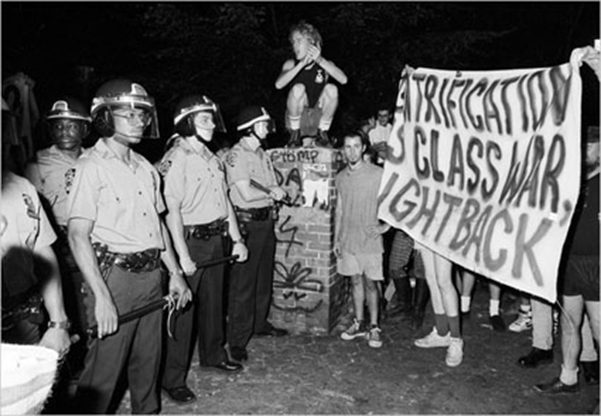Physical Address
304 North Cardinal St.
Dorchester Center, MA 02124
Physical Address
304 North Cardinal St.
Dorchester Center, MA 02124
The market urbanism axiom — permitting housing supply to increase is key to achieving affordable housing — has been made recently by Rick Jacobus at Shelterforce and Daniel Hertz at City Observatory. However both argue that even with an increasing supply, low-income people will need aid in order to afford what the authors feel is adequate housing. History shows us, though, that if developers are allowed to serve renters in every price range, they will. The movie Brooklyn portrays the type of housing many of our grandparents and great-grandparents lived in when they emigrated to the United States. People of very little means could afford to live in cities with the highest housing demand because they lived in boarding houses, residential hotels, and low-quality apartments, most of which are illegal today. Making housing affordable again requires not only permitting construction of more new units, but also allowing existing housing to be used in ways that are illegal under today’s codes. Young adults living in group houses with several roommates have found a way around these regulations, but low-income renters were better-served when families and single people could pay for housing that was designed to meet their needs at an affordable price. Alan During explains the confluence of interest groups that successfully eliminated cheap, low-quality housing: The rules were not accidents. Real-estate owners eager to minimize risk and maximize property values worked to keep housing for poor people away from their investments. Sometimes they worked hand-in-glove with well-meaning reformers who were intent on ensuring decent housing for all. Decent housing, in practice, meant housing that not only provided physical safety and hygiene but also approximated what middle-class families expected. This coalition of the self-interested and the well-meaning effectively boxed in and shut down rooming houses, and it erected barriers to in-home boarding, too. Over more than a century, […]

When it comes to the impact autonomous cars will have on cities, there’s plenty of room for disagreement. Will they increase or decrease urban densities? Will they help with congestion or make it worse? At the same time, there seems to be widespread agreement on at least two things: First, far fewer people will own cars. Second, we are not going to need nearly as much parking. By combining the technology of autonomous cars with the business model of transportation network companies like Uber and Lyft, low-cost, on-demand ride-hailing and dynamic routing bus lines could eliminate the need to keep an unused car hanging around for most of the day. When that happens, we will need far fewer parking spaces, turning on-street parking into wider sidewalks and bike lanes and surface lots and parking ramps into residential and commercial uses. So how does the humble American residential garage fit into all this? On its face, the garage is little more than the sheltered parking space that comes with most single-family homes. Yet the garage holds a certain mythological status in the American psyche: It gave rise to iconic American brands like Disney, Harley Davidson, and Mattel. It offered a space in which the firms that would launch the digital economy could get their start, including HP and Apple. Google and Microsoft, which both started in garages, maintain “garage” work spaces to this day in order to cultivate innovation. By providing a flexible space in which knowledge, free time, and ambition can transform into entrepreneurial innovation, the garage has played a crucial role in the American economy. At least in the near term, garages are not going anywhere. Unlike municipal governments and large private landowners who will likely face immediate political and market pressures to retool their parking spaces, many homeowners are structurally stuck with their garages. Millions of garages could go unused, occasionally kept active by automobile hobbyists, most likely turning into de facto storage units. But it doesn’t have to be […]
To market urbanists and many others, it’s clear that there is a positive relationship between high housing costs and land-use restrictions and that liberalizing zoning would lower housing costs relative to what they would be in a more regulated environment. Given this relationship, reducing zoning would improve efficiency in the housing market by allowing consumer demand to drive the amount of resources that are put into housing development. However, land-use reform would also affect other policy areas such as public schools, transportation infrastructure, and sewer and water provision. Predicting how a liberalizing reform in one policy area will affect the complete public policy landscape is as impossible as predicting how one private sector innovation will affect other markets. Political scientist Steven Teles coined the term “kludgeocracy” to describe the complexity of contemporary American policy. For example, zoning has become a tool to make high-performing public schools exclusive, even though land-use policy and education policy are seemingly unrelated areas governed by different agencies. Because providing zero-price quality education to every child in the country may be impossible, zoning is a kludge that allows policymakers to provide this service to their high-income and influential constituents. Teles describes this policy complexity: A “kludge” is defined by the Oxford English Dictionary as “an ill-assorted collection of parts assembled to fulfill a particular purpose…a clumsy but temporarily effective solution to a particular fault or problem.” The term comes out of the world of computer programming, where a kludge is an inelegant patch put in place to solve an unexpected problem and designed to be backward-compatible with the rest of an existing system. When you add up enough kludges, you get a very complicated program that has no clear organizing principle, is exceedingly difficult to understand, and is subject to crashes. Any user of Microsoft Windows will immediately grasp the concept. […]

Washington, D.C. has a monopoly on many things. Bad policy, unfortunately, isn’t among them. Last month, a development corporation in Lexington, Kentucky installed a shipping container house in an economically distressed area of town to improve housing affordability. The corporation is a private non-profit, though a line near the end of this article indicates that the project received public support: “The project is funded through an assortment of grants from the city’s affordable housing fund [and two philanthropic organizations].” Shipping container projects designed to improve housing affordability aren’t limited to my Old Kentucky Home: a quick Google search reveals that the idea of using shipping containers to put a dent in housing costs is popular among policymakers and philanthropists all over the world. The sad reality is that shipping container homes likely have little—if any—role to play in handling the nationwide housing affordability problem. Aside from being inefficient for housing generally, there’s decent evidence that shipping containers appeal far more to reasonably well-off, single urbanites than to working families in need of affordable housing. More broadly, the belief that these projects could address the growing affordability crisis hints at a profound misunderstanding of the nature of the problem and distracts policymakers from viable solutions. Before digging into the meatier problems, it’s worth looking first at the problems with the structures themselves. I’ll yield to an architect: Housing is usually not a technology problem. All parts of the world have vernacular housing, and it usually works quite well for the local climate. There are certainly places with material shortages, or situations where factory built housing might be appropriate—especially when an area is recovering from a disaster. In this case prefab buildings would make sense—but doing them in containers does not. The source goes on to detail the enormous costs associated with zoning approval, insulation, and utilities. Then there’s the somewhat obvious fact that they’re small. As in, 144 square […]
In political transactions, players cannot make deals using dollars, but nonetheless they engage in trades to pursue their goals. Policymakers may engage in trades both with other policymakers and with private sector actors . While these deals are not denominated in dollars, their gains from trade can still be considered “profit” that goes to the parties to the trade. In the decision to create the DC Metro’s silver line extending from West Falls Church to Dulles International Airport, many public sector and private sector parties profited from the complex dealmaking that facilitated the extension. The Silver Line was accompanied by redevelopment planning for Tysons Corner, a suburb of DC along the line’s route. These rail construction and accompanying rezoning benefitted three primary groups. The first and most obvious beneficiaries of the development of the Silver Line were the individuals and corporations that owned large parcels of land near the planned stations. The value of their holdings increased not only because of the new infrastructure, but also because the planning for the Silver Line involved significant upzoning, making more intensive and profitable use of their land legal. The combined promise of upzoning and the new metro stations ensured local policymakers that powerful landowners would support their efforts. These large landowners who benefited from upzoning include West Group, Tysons Corner Property, and West Mac Associates among other. The leadership members of these corporations were active in commenting on the proposed changes to the area’s land use and transportation plans. Because of its large investment in Tysons Corner and its corresponding importance in the development process, West Group has had special involvement in the redevelopment process. Implementing the proposed grid of streets relies heavily on West Group properties and other major developers cooperating to minimize the need to use eminent domain to achieve the infrastructure requirements to facilitate increased […]
Yesterday the Cato Institute hosted an event featuring William Fischel’s discussion of his new book Zoning Rules! with commentary by Mark Calabria, Matt Yglesias, and Robert Dietz. Fischel explained his theory that zoning was an effective tool for minimizing nuisances between land uses through the 1970s. Until that time, he asserts that city planners did a good job of separating incompatible land uses, such as industrial and residential uses, benefiting residents and protecting home values in the process. His theory is that in the 1970s, inflation increased the value of homeownership relative to cash savings, leading homeowners to increasingly view their houses as investments. At the same time, the rise of environmentalism provided the policy justification for using zoning as a tool to limit the growth of housing supply. According to his theory, homeowners then began using their power to lobby for downzoning to protect their large, undiversified asset, and valued minimizing any potential downside risk in their home value. In his discussion of Fischel’s book, Matt Yglesias pointed out that today, NIMBYism has gone far beyond keeping out polluting land uses and low-income neighbors. For example, some residents in San Francisco’s Mission District are supporting a moratorium on luxury housing development, and some Brooklyn residents are fighting to keep vacant industrial properties in place on the waterfront. Permitting high-end residential development in these neighborhoods would be more likely to raise than lower nearby homeowners’ property values. This opposition to development is at odds with Euclidean zoning in these neighborhoods where expensive housing now abuts abandoned warehouses. It’s also demonstrates that NIMBYs are not motivated by narrow profit interests, but have complex preferences that are not easily understood by observing the policies that they advocate for. In the private sector, profit is measured in money, and it’s generally safe to say that both parties to a transaction […]
Housing prices in San Francisco are obscene. And, in large part, that’s because the city hasn’t permitted enough new construction. But that’s not the entire story. For as hard as San Francisco has resisted development, the Peninsula cities have resisted it even more. And in so doing they’ve pushed the responsibility of development onto their Northern neighbor. If San Francisco’s housing crisis is to be resolved, the Peninsula cities will have to quite literally grow up. Bad Neighbors San Francisco is synonymous with tech, but there’s plenty going on just down the road. Menlo Park has Facebook. Mountain View has both Google and Linkedin. These two cities alone are home to over 1,300 other tech companies and the story’s much the same elsewhere on the Peninsula. But where firms have sprung up and jobs have become abundant, housing has remained in short supply. Tech companies bus an estimated 7,500 workers from San Francisco apartments to Peninsula offices every day. They don’t do this for fun. There’s simply not enough housing near major employers. And what is available is often unaffordable, even for tech workers. But if housing prices are as bad or worse on the peninsula, one might ask why we only hear the word “crisis” in San Francisco. The reason is simple. What makes for crisis in San Francisco is nothing but windfall to the South. According to the U.S. Census, San Francisco’s homeownership rate is 36.6%. Mountain View’s is 41.8%, San Mateo’s is 53.6%, Palo Alto’s is 55.4%, Menlo Park’s is 56.2%, and Cupertino’s is 63.7%. Homeowners in these cities aren’t faced with skyrocketing rent. And thanks to Prop 13, they also pay almost nothing in property tax–no matter how much their homes appreciate in value. They not only face no downside from the anti-development status quo, they […]

Over at Greater Greater Washington, Ms. Cheryl Cort attempts to temper expectations of what she calls the “libertarian view (a more right-leaning view in our region)” on affordable housing. It is certainly reassuring to see the cosmopolitan left and the pro-market right begin to warm to the benefits of liberalization of land-use. Land-use is one area the “right,” in it’s fear of change, has failed to embrace a widespread pro-market stance. Meanwhile, many urban-dwellers who consider themselves on the “left” unknowingly display an anti-outsider mentality typically attributed to the right’s stance on immigration. Unfortunately, in failing to grasp the enormity of the bipartisan-caused distortion of the housing market, Ms. Cort resigns to advocate solutions that fail to deliver widespread housing affordability. Yes, adding more housing must absolutely be a part of the strategy to make housing more affordable. And zoning changes to allow people to build taller and more usable space near transit, rent out carriage houses, and avoid expensive and often-unnecessary parking are all steps in the right direction. But some proponents go on to say relaxing zoning will solve the problem all on its own. It won’t. Well, if “relaxing” zoning is the solution at hand, she may be right – relaxing will only help a tad… While keenly aware of the high prices many are willing to pay, Cort does not seem to grasp the incredible degree to which development is inhibited by zoning. “Relaxing” won’t do the trick in a city where prices are high enough to justify skyscrapers with four to ten times the density currently allowed. When considering a supply cap that only allows a fraction of what the market demands, one can not reasonably conclude “Unlimited FAR” (building density) would merely result in a bit more development here and there. A radically liberalized land-use regime would […]

Gentrification is the result of powerful economic forces. Those who misunderstand the nature of the economic forces at play, risk misdirecting those forces. Misdirection can exasperate city-wide displacement. Before discussing solutions to fighting gentrification, it is important to accept that gentrification is one symptom of a larger problem. Anti-capitalists often portray gentrification as class war. Often, they paint the archetypal greedy developer as the culprit. As asserted in jacobin magazine: Gentrification has always been a top-down affair, not a spontaneous hipster influx, orchestrated by the real estate developers and investors who pull the strings of city policy, with individual home-buyers deployed in mopping up operations. Is Gentrification a Class War? In a way, yes. But the typical class analysis mistakes the symptom for the cause. The finger gets pointed at the wrong rich people. There is no grand conspiracy concocted by real estate developers, though it’s not surprising it seems that way. Real estate developers would be happy to build in already expensive neighborhoods. Here, demand is stable and predictable. They don’t for a simple reason: they are not allowed to. Take Chicago’s Lincoln Park for example. Daniel Hertz points out that the number of housing units in Lincoln Park actually decreased 4.1% since 2000. The neighborhood hasn’t allowed a single unit of affordable housing to be developed in 35 years. The affluent residents of Lincoln Park like their neighborhood the way it is, and have the political clout to keep it that way. Given that development projects are blocked in upper class neighborhoods, developers seek out alternatives. Here’s where “pulling the strings” is a viable strategy for developers. Politicians are far more willing to upzone working class neighborhoods. These communities are far less influential and have far fewer resources with which to fight back. Rich, entitled, white areas get down-zoned. Less-affluent, disempowered, minority […]
Want to live in San Francisco? No problem, that’ll be $3,000 (a month)–but only if you act fast. In the last two years, the the cost of housing in San Francisco has increased 47% and shows no signs of stopping. Longtime residents find themselves priced out of town, the most vulnerable of whom end up as far away as Stockton. Some blame techie transplants. After all, every new arrival drives up the rent that much more. And many tech workers command wages that are well above the non-tech average. But labelling the problem a zero sum class struggle is both inaccurate and unproductive. The real problem is an emasculated housing market unable to absorb the new arrivals without shedding older residents. The only solution is to take supply off its leash and finally let it chase after demand. Strangling Supply From 2010 to 2013, San Francisco’s population increased by 32,000 residents. For the same period of time, the city’s housing stock increased by roughly 4,500 units. Why isn’t growth in housing keeping pace with growth in population? It’s not allowed to. San Francisco uses what’s known as discretionary permitting. Even if a project meets all the relevant land use regulations, the Permitting Department can mandate modifications “in the public interest”. There’s also a six month review process during which neighbors can contest the permit based on an entitlement or environmental concern. Neighbors can also file a CEQA lawsuit in state court or even put a project on the ballot for an up or down vote. This process is heavily weighted against new construction. It limits how quickly the housing stock can grow. And as a result, when demand skyrockets so do prices. To remedy this, San Francisco should move from discretionary to as-of-right permitting. In an as-of-right system, it’s much […]